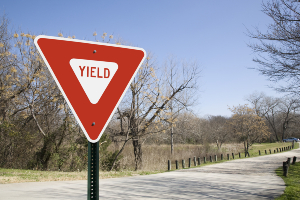Do you know everything you need to know about New Mexico’s right-of-way traffic laws? All New Mexico drivers, motorcyclists, bicyclists, and pedestrians should do what they can to avoid a vehicle crash. Understanding and following New Mexico’s traffic laws, such as the ‘New Mexico Left Turn Intersection Law,’ is crucial to prevent accidents and avoid getting a ticket. When you yield the right-of-way to another vehicle, you are letting them proceed before you. Failure to yield the right-of-way leads to many crashes.
The right-of-way is the legal right to proceed across any road. Right-of-way laws exist to help keep traffic flowing smoothly and prevent collisions between cross-traffic. The New Mexico statute provides a general foundation for yielding the right-of-way, outlining specific rules for drivers and pedestrians in various scenarios. The law does not give the right-of-way to anyone, but it does specify who must yield or give up the right-of-way.
Understanding Right-of-Way Laws
Definition and Purpose
Right-of-way laws are essential for ensuring the safe and efficient movement of traffic on public roads and highways. These laws are designed to prevent accidents and injuries by establishing clear rules for drivers, pedestrians, and other road users. Essentially, right-of-way laws dictate who has the priority to proceed through an intersection or cross a road, and who must yield to others. By understanding who must yield in various situations, everyone can navigate the roads more safely and effectively.
Types of Right-of-Way
There are several types of right-of-way that you should be aware of:
- Public right-of-way: This refers to the right of the public to use a road or highway for travel. Public right-of-way ensures that everyone has access to roads and highways, facilitating smooth and efficient traffic flow.
- Private right-of-way: This refers to the right of a private individual or entity to use a road or highway for travel. Private roads are typically owned by individuals or organizations and may have specific rules or restrictions.
- Easement: This is a type of right-of-way that allows a person or entity to use someone else’s property for a specific purpose, such as accessing a public road or utility lines. Easements are common for utility companies that need to repair power lines or other infrastructure.
Understanding these different types of right-of-way can help you navigate various road situations more effectively and ensure that you are complying with the law.
Who Has The Right Of Way At a Four-Way Stop
At a four-way stop, the vehicle that reaches the intersection first has the priority to proceed. If several vehicles arrive simultaneously, the one located on the right has the right of way.
Who Has the Right-of-Way at a Yield Sign?
A yield sign alerts drivers to slow down and yield the right-of-way to pedestrians and vehicles approaching from another direction. If there is a yield line painted on the pavement, drivers must yield the right-of-way to the other driver before crossing the yield line.
Who Has the Right-of-Way at a Stop Sign?
According to New Mexico Statutes Section 66-7-330, the driver of a vehicle approaching a stop sign on New Mexico’s roads must stop and give the right-of-way to vehicles that have entered the intersection or approached close enough to constitute an immediate hazard.
Yielding at intersections: The “Driver on the Right” Rule
Most drivers typically misunderstand the “Yield to the Driver on the Right” rule. This rule controls most intersections when drivers arrive simultaneously. Suppose you come upon a stop sign simultaneously with another driver in a cross street, and they are on your right. In that case, you should yield the right-of-way to the other driver and let him go first.
Assuming there is no sign prohibiting a right turn on red, you are allowed to make the turn after coming to a complete stop and yielding to pedestrians, cyclists, other vehicles, or any unexpected obstacles in your path.
Who Has the Right-of-Way at a Public Intersection?
At a four-way intersection, traffic in all four directions is required to stop. According to New Mexico’s traffic laws, the first vehicle reaching the intersection should move forward first. Suppose two cars reach an uncontrolled intersection at close to the same time. In that case, the car getting to the intersection last must yield the right-of-way. If both cars reach the intersection simultaneously, the driver on the left should yield the right-of-way.
When Does a Pedestrian Have the Right-of-Way?
You always yield the right-of-way to a pedestrian, even if they are crossing the roadway illegally. No matter the circumstances, you must yield to any pedestrian walking with a guide dog or a white cane.
Do Bicycles or Motorcycles Ever Have the Right-of-Way?
Since bikes are considered vehicles, a bicycle rider is subject to the same rules and duties as the driver of a vehicle. Bicycles should stay as near to the right side of the roadway as possible. Bicycle riders should operate their bikes in a way that does not cause a public safety hazard.
Special Situations
Utility Work and Repair Power Lines
When utility work or the repair of power lines is being performed on a public road or highway, special right-of-way rules may apply. In these situations, utility workers often have the right-of-way to access the road or highway to perform their duties safely. Drivers must yield to these workers and follow any specific instructions or detours that are in place to ensure everyone’s safety.
It’s important to note that right-of-way laws can vary depending on the jurisdiction, so it’s always a good idea to familiarize yourself with the specific laws and regulations in your area. By understanding and following right-of-way laws, you can help prevent accidents and ensure a safe and efficient flow of traffic. Always use common sense and care when approaching areas where utility work is being performed, and remember that the safety of the workers and other road users should be your top priority.
Some Right-of-Way Decisions Are a Matter of Common Sense
There are some right-of-way traffic rules that you should know. Many of these decisions to yield the right-of-way involve using common sense. These rules include:
- Always yield the right-of-way to a police or emergency vehicle, construction vehicles, road workers, and school buses.
- When turning left at an intersection, please do not turn into oncoming traffic. Yield to oncoming traffic.
- When merging into traffic, do not pull out in front of a driver and force them to slow down. Yield to oncoming traffic.
- Drivers should be aware of areas in which they drive most frequently and should have a basic knowledge of other frequently traveled streets or roadways.
- Drivers should consider how the right-of-way will affect their travel and should use their discretion regarding travel plans and the environment.
- Drivers should try to anticipate other drivers’ actions and yield whenever necessary. Giving the right-of-way to other drivers helps to avoid crashes.
- Always follow the speed limit to avoid accidents and traffic violations.
Penalties for Violating New Mexico’s Right-of-Way Laws
If you fail to yield-the-right-way in New Mexico, you will pay fines and legal costs of $80. Your driver’s license will have three demerit points attached. Failure to yield the right-of-way to an emergency vehicle will result in four demerit points attached to your license. These penalties are part of New Mexico’s traffic laws designed to ensure road safety.
Accidents will happen when drivers negligently fail to follow traffic laws. Running yellow or red blinking lights, failing to yield, making a left-hand turn, or merging onto a highway or roadway without yielding to existing traffic are examples of negligence.
Speak with an Experienced New Mexico Personal Injury Lawyer
Suppose you are injured in a New Mexico car accident caused by another driver’s failure to yield the right-of-way to you. In that case, you might be entitled to financial compensation from the at-fault driver’s auto insurance provider.
The personal injury attorneys at Dominguez Law are experienced litigators who handle personal injury and mass tort cases in New Mexico. They fight for justice for seriously injured clients, holding the responsible parties accountable for their negligent actions.
Our experienced lawyers will work tirelessly and may be able to secure compensation for your injuries, losses, and damages. Schedule a free consultation by calling (505) 850-5854 or filling out our contact form.
Q&A For Right-Of-Way Law
What is the legal right of way when turning left at an intersection?
When turning left, drivers must yield to oncoming traffic that is close enough to pose an immediate hazard. Failing to yield violates state law and can lead to accidents, making it crucial to ensure the intersection is clear before proceeding.
How can understanding right-of-way laws prevent financial compensation disputes after an accident?
Right-of-way laws clarify who must yield in various traffic scenarios. Violating these laws can make a driver liable for an accident, affecting their ability to claim financial compensation. Following these rules reduces liability risks and ensures safer roadways.
What are the rules for turning left when yielding the right-of-way?
When turning left, you must yield to oncoming traffic and pedestrians. State law mandates that you wait until the path is clear to avoid obstructing other vehicles, minimizing risks of collisions and liability for accidents.
Why is yielding to pedestrians essential for complying with state law?
Yielding to pedestrians is mandatory under state law, even if they are crossing illegally. Protecting pedestrian safety is prioritized, and failure to yield can result in fines, legal penalties, and reduced eligibility for financial compensation in accidents.
What happens if two vehicles arrive at a four-way stop simultaneously?
When two vehicles arrive at a four-way stop simultaneously, the driver on the right has the legal right of way. State law dictates that the other driver must yield, ensuring fairness and preventing confusion in traffic flow.
Can failing to yield while turning left result in legal or financial consequences?
Yes, failing to yield while turning left can lead to traffic violations, fines, and increased liability in accidents. State law prioritizes safe driving practices, and noncompliance can affect your ability to seek financial compensation if you are found at fault.


